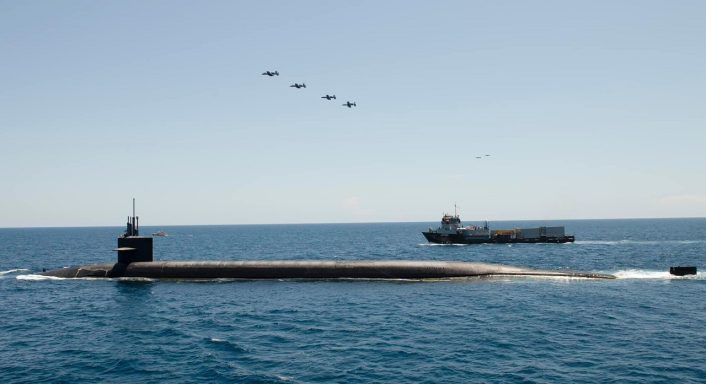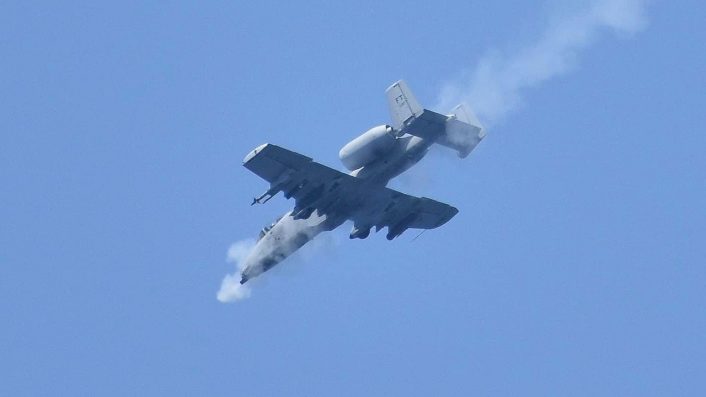For the second time in the last few months, A-10C jets escorted an Ohio-class nuclear submarine and also took part in a life fire exercise.
A formation of A-10C Thunderbolt II close-air support aircraft were employed once again to escort an Ohio-class ballistic missile submarine, the USS Wyoming (SSBN 742). The images, shared on social media by Submarine Group Ten, depict Wyoming and its escorts navigating in an undisclosed location in the United States, with six A-10Cs flying overhead.
The aircraft, assigned to Moody Air Force Base, escorted the submarine and were also involved in a live fire exercise with their GAU-8 30 mm gun and 70 mm rockets. The U.S. Coast Guard Maritime Force Protection Unit Kings Bay, USNS Black Powder (T-AGSE-1), and USNS Westwind (T-AGSE-2) also participated in the escort of the submarine.
The rare sighting is not unprecedented, as earlier this year the USS Nebraska was also escorted by a quartet of A-10 Warthogs while navigating the Strait of San Juan de Fuca. In that occasion, however, the A-10s did not take part in any life fire activity and flew without carrying external ordnance.
“Joint operations, such as this one which involved the Air Force, Coast Guard, and Navy, ensure the U.S. military is ready to meet its security commitments at home and abroad,” mentioned the statements on both occasions. The services did not further elaborate on the extend of the joint operations.
The A-10C and the maritime domain
While no other details were released, it appears the Warthogs practiced overwatch of the extremely high-value strategic asset during one of the most vulnerable phases of its navigation. The live fire exercise might have also been used to simulate the defense of the USS Wyoming from surface threats.
A-10s have been used to target swarms of boats and to strike small naval vessels in previous training exercises, demonstrating the attention that these types of asymmetric threats attracted following recent real word events, such the attacks in the Red Sea or the Black Sea.

The A-10, which was born as a pure Close Air Support and anti-tank platform, has never been employed to large extent in the maritime domain, seeing only limited use. One of the most notable episodes was in 2011 during Operation Unified Protector, when an A-10 and a P-3C Orion engaged together a patrol boat and several small attack craft in the port of Misrata, Libya.
Since the last two couple of years, the Warthog was part of multiple Maritime Surface Warfare exercises and conducted unit defense training. One of the exercises saw, in Sept. 2023, two A-10s engage simulated surface threats in the Gulf of Oman with the Arleigh Burke-class guided-missile destroyer USS Stethem.
The A-10’s maneuverability at low airspeeds and altitude, highly accurate weapons-delivery capabilities, and extended loiter time are all key attributes that make it highly effective at providing aerial support to American and coalition forces on land and at sea, mentioned the U.S. Air Force after one of these exercises last year.
Asymmetric threats to maritime assets
The events in the Black Sea and Red Sea highlighted once again how asymmetric threats cannot be underestimated. In the past, the U.S. Navy had experience countering small fast attack crafts, especially in the Persian Gulf where Iran regularly harassed U.S. ships in the area.
More recently, Ukraine and the Houthis demonstrated the effectiveness and the danger posed by Unmanned Surface Vehicles (USVs), used in kamikaze attacks against larger ships. The small, unmanned boats, filled with explosives, can exploit their limited dimensions and high maneuverability to avoid detection and interception, with devastating effects on their targets.

Highly defended targets could be overwhelmed by coordinated swarms of USVs, challenging the traditional naval strategies. The presence of multiple, fast approaching and maneuvering targets against a limited number of weapon systems on a naval asset could confuse the defenses, which would be forced to prioritize targets as to maximize the hit probability and avoid wasting precious ammo.
And here is where overhead protection from and asset like the A-10C could come in handy, as it provides to naval commanders a number of options both for surveillance and kinetic effects.

